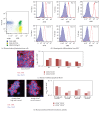The Aryl Hydrocarbon Receptor Relays Metabolic Signals to Promote Cellular Regeneration
- PMID: 27563312
- PMCID: PMC4987465
- DOI: 10.1155/2016/4389802
The Aryl Hydrocarbon Receptor Relays Metabolic Signals to Promote Cellular Regeneration
Abstract
While sensing the cell environment, the aryl hydrocarbon receptor (AHR) interacts with different pathways involved in cellular homeostasis. This review summarizes evidence suggesting that cellular regeneration in the context of aging and diseases can be modulated by AHR signaling on stem cells. New insights connect orphaned observations into AHR interactions with critical signaling pathways such as WNT to propose a role of this ligand-activated transcription factor in the modulation of cellular regeneration by altering pathways that nurture cellular expansion such as changes in the metabolic efficiency rather than by directly altering cell cycling, proliferation, or cell death. Targeting the AHR to promote regeneration might prove to be a useful strategy to avoid unbalanced disruptions of homeostasis that may promote disease and also provide biological rationale for potential regenerative medicine approaches.
Figures


Similar articles
-
Tryptophan Metabolism Activates Aryl Hydrocarbon Receptor-Mediated Pathway To Promote HIV-1 Infection and Reactivation.mBio. 2019 Dec 17;10(6):e02591-19. doi: 10.1128/mBio.02591-19. mBio. 2019. PMID: 31848275 Free PMC article.
-
The interplay of the aryl hydrocarbon receptor and β-catenin alters both AhR-dependent transcription and Wnt/β-catenin signaling in liver progenitors.Toxicol Sci. 2011 Aug;122(2):349-60. doi: 10.1093/toxsci/kfr129. Epub 2011 May 20. Toxicol Sci. 2011. PMID: 21602191
-
Mitochondrial-targeted aryl hydrocarbon receptor and the impact of 2,3,7,8-tetrachlorodibenzo-p-dioxin on cellular respiration and the mitochondrial proteome.Toxicol Appl Pharmacol. 2016 Aug 1;304:121-32. doi: 10.1016/j.taap.2016.04.005. Epub 2016 Apr 20. Toxicol Appl Pharmacol. 2016. PMID: 27105554 Free PMC article.
-
Role of aryl hydrocarbon receptor in cancer.Biochim Biophys Acta. 2013 Dec;1836(2):197-210. doi: 10.1016/j.bbcan.2013.05.001. Epub 2013 May 24. Biochim Biophys Acta. 2013. PMID: 23711559 Review.
-
Aryl hydrocarbon receptor activation mediates kidney disease and renal cell carcinoma.J Transl Med. 2019 Sep 5;17(1):302. doi: 10.1186/s12967-019-2054-5. J Transl Med. 2019. PMID: 31488157 Free PMC article. Review.
Cited by
-
Intestinal epithelial cell metabolism at the interface of microbial dysbiosis and tissue injury.Mucosal Immunol. 2022 Apr;15(4):595-604. doi: 10.1038/s41385-022-00514-x. Epub 2022 May 9. Mucosal Immunol. 2022. PMID: 35534699 Free PMC article. Review.
-
T-Cell Metabolism in Hematopoietic Cell Transplantation.Front Immunol. 2018 Feb 9;9:176. doi: 10.3389/fimmu.2018.00176. eCollection 2018. Front Immunol. 2018. PMID: 29479351 Free PMC article. Review.
-
Anti-Aging Physiological Roles of Aryl Hydrocarbon Receptor and Its Dietary Regulators.Int J Mol Sci. 2020 Dec 31;22(1):374. doi: 10.3390/ijms22010374. Int J Mol Sci. 2020. PMID: 33396477 Free PMC article. Review.
-
Ex vivo HSC expansion challenges the paradigm of unidirectional human hematopoiesis.Ann N Y Acad Sci. 2020 Apr;1466(1):39-50. doi: 10.1111/nyas.14133. Epub 2019 Jun 14. Ann N Y Acad Sci. 2020. PMID: 31199002 Free PMC article. Review.
-
Kynurenic Acid/AhR Signaling at the Junction of Inflammation and Cardiovascular Diseases.Int J Mol Sci. 2024 Jun 25;25(13):6933. doi: 10.3390/ijms25136933. Int J Mol Sci. 2024. PMID: 39000041 Free PMC article. Review.
References
-
- Ploemacher R. E., Van Der Loo J. C. M., Van Der Sluijs J. P., et al. In vitro assays for primitive hematopoietic cells. Blood. 1992;79(3):834–836. - PubMed
-
- Taswell C. Limiting dilution assays for the determination of immunocompetent cell frequencies. I. Data analysis. The Journal of Immunology. 1981;126(4):1614–1619. - PubMed
Publication types
LinkOut - more resources
Full Text Sources
Other Literature Sources

